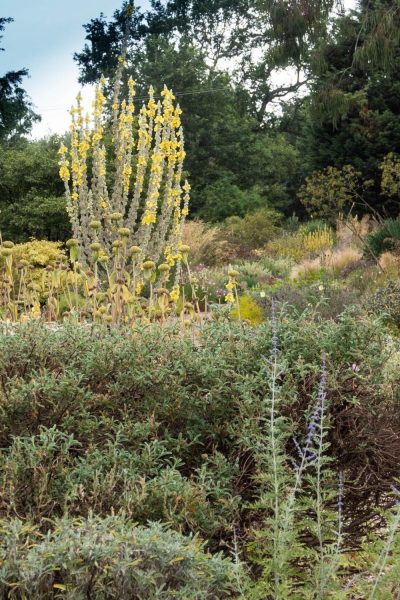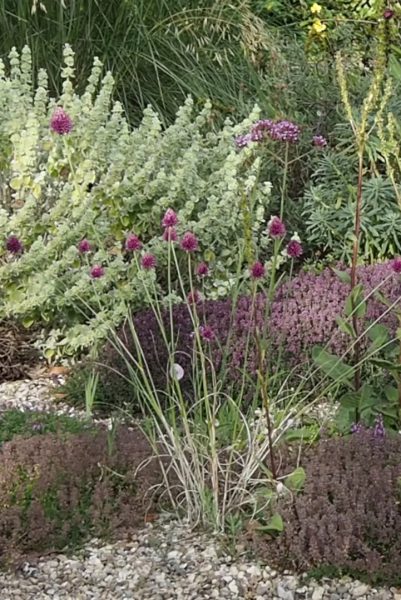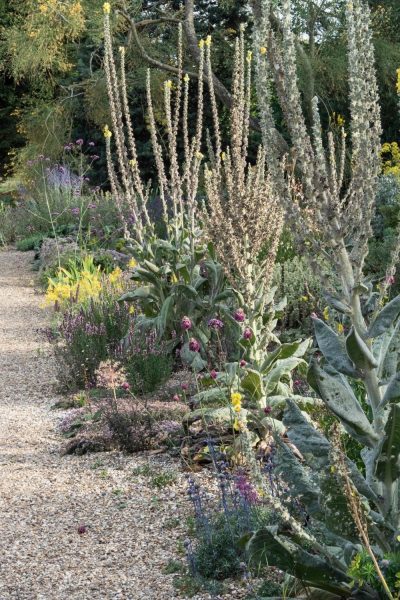[ad_1]
The UK’s most famous dry garden is at the Beth Chatto gardens in Essex.
So I visited to talk to head gardener, Asa Gregor-Warg, about how to make a dry garden in our own gardens. It’s also often known as a gravel garden.
Asa Gregor-Warg, head gardener at Beth Chatto Gardens.
What is a dry garden?
A dry garden is one which is never watered, says Asa.
It’s planted with drought-resistant plants and usually has a gravel mulch. This looks good and helps retain moisture in the soil.
The Beth Chatto gardens are in Essex. Like Kent, where I live, it is on the very dry Eastern side of the UK. It is common to have a month or so without rain in the summer.
The Beth Chatto dry garden was created by Beth Chatto herself in 1992. It is where the car park used to be. ‘This area was so dry that native weeds used to curl up and die,’ says Asa. ‘It’s very poor, free-draining soil, with gravel in it. There are several gravel pits locally.’
Now it is one of the UK’s most famous gardens, open to the public. People come from far away to see the interesting plants, many of which are sold at the nursery.

The dry garden at Beth Chatto Gardens.
The nursery sells plants online, too. It has a particularly useful list of plants for dry borders.
Is a gravel garden suitable for all gardens?
Asa often gets this question from people who live in an area with very heavy clay soil, and more rain fall. ‘We wouldn’t advise you to try a gravel garden in those conditions. But if you have very poor, free-draining soil, it’s a good choice.
Preparing the soil for planting a dry border
‘We improve the soil a bit when we plant the border,’ she explains. They incorporate organic matter, such as homemade compost, into the soil, but not too much. ‘If you make it too rich, you would get lush, green growth which would need more water,’ she explains.
As the garden is now over 25 years old, they are renewing it border by border. ‘We dig up the plants and strip off the gravel mulch,’ she says. ‘It wouldn’t be good to incorporate it because that would make the soil even more free draining.’ Then they mix in the compost and plant a whole section of the border at once.
‘If you dig an individual hole for a plant in a dry border, and then plant it, backed up with organic matter, its roots will just stay in their little pockets.’
Beth Chatto originally used cow manure, but they currently use garden compost. ‘We don’t want to make the soil too rich,’ says Asa.

Giant mullein (or Verbascum bombyciferum) towers above the planting.
Best dry garden plants
The main quality the plants need is to be drought tolerant, says Asa. ‘They don’t necessarily come from the same part of the world.
Look for small-leaved plants, silvery foliage and succulent foliage. There’s a good list on the Beth Chatto website.

You can see interesting varieties of plants at Beth Chatto Gardens and see how they look when planted. Almost all are labelled, too.
They include agapanthus, alliums, artemisia, eryngium and erigeron, along with lots more. I recognised many of the plants that do well in my garden, and we, too, live on the dry, Eastern side of the UK.
‘Buy smaller, younger plants,’ she advises. ‘Smaller and younger plants will get established more easily than larger, more mature ones.’

Watering new plants in a dry border
Although a dry garden is never irrigated on a regular basis, plants need a little extra help when you plant them. At Beth Chatto Gardens, they soak the rootball in a bucket of water for a few hours before planting.
Then once planted, the plant is giving a thorough watering. ‘Then we wait a week or two and usually give a second good watering to the roots,’ says Asa. ‘Most of the time we never water twice, but if it’s a slightly larger shrub, we keep an eye on it and may give it some more water until it gets its roots established.’
Does a dry garden always need gravel?
The gravel mulch helps keep moisture in the soil, ‘but any mulch will do that,’ says Asa. ‘We use straw at the back, where people can’t see.’
Gravel, however, looks good and it means the paths can ebb and flow between the borders.
They never use a membrane beneath the gravel, because it always works up and would be visible, which is ugly. ‘And perennial plants need to spread under the soil,’ says Asa. ‘If you cut a hole in a membrane to plant a tree or a shrub, that’s fine, but it doesn’t work for perennials.’
How do you plan a dry border?
‘Beth Chatto used the principles of ikebana, or an assymetrical triangle, when she was designing borders,’ says Asa. ‘We don’t follow the usual rules of planting borders, with taller plants at the back.’
Ikebana majors on shape and structure rather than colour. It’s based around three points in an assymetrical triangle. These correspond to heaven, earth and humanity.
‘We plant in assymetrical triangles,’ says Asa. ‘There will be a tall plant, reaching up to heaven, a middle plant that stands for humanity and ground cover for earth.’

Look for assymetrical triangles and Ikebana principles of planting.
The three triangle design isn’t obvious, says Asa, ‘but if you look closely there’s always something taller leading the eye up, a middle layer and ground cover. There may be one assymetrical triangle in a border, or several. But it always feels very natural.’

The verbascum are reaching up to heaven, the ground cover represents ‘earth’ and the level in between is ‘humanity.’ Repeating plants leads the eye along the border, says Asa.
What would your garden look like in a black and white photograph?
‘Think in black and white,’ advises Asa.
If a border has shape and structure, it will be just as strong in black and white as in colour.

To try this out, I turned one of my photos of the Beth Chatto garden into black & white. The structure and sense of the garden is still there. And you can see individual plants, too. Try it with your own borders! I did – some worked and others just looked like a muddle.
Negative space is also important
This style of planting is completely different from a closely packed herbaceous border or cottage garden style.
‘Negative space is very important,’ says Asa. ‘Don’t cram in too many plants. Then you can appreciate the plants’ shape and form.’
Some plants have space around them. Or if they are planted in groups, the group will have space around it.

You can appreciate the shape and structure of the plants by leaving spaces around the plants or groups of plants. The grasses are Stipa tenuissima, sometimes known as Ponytail grass.
Is a dry garden low maintenance?
Asa says that a dry garden is not low maintenance. The gravel creates an ideal environment for weed seeds, because it traps warmth and moisture in the soil. ‘So we spend much more time weeding the dry garden than the rest of the garden,’ she says.
Self seeded annuals are also an important part of the look, so hand weeding is vital. Self-seeded poppies and nigella must be sorted from weeds. ‘Much of our weeding is also editing, looking at what we’ve got and imagining how it will look later on in the year. And we have to do this carefully because we don’t want to mix even more gravel into the soil.’
If you want a low maintenance dry garden, Asa recommends that you major on dry garden ground covers, such as thyme.
More about Beth Chatto Gardens
Beth Chatto was a major pioneer of the idea that plants flourish best in conditions most close to their natural habitat. She and her husband Andrew’s home was a very challenging site for a garden. It had damp, almost boggy areas, shady areas, dry areas with poor soil and even a sloping area.
In the 1960s, when Beth started gardening, gardens were supposed to have traditional herbaceous borders, lawns and shrubberies, regardless of where they were.

Agave and Phlomis russelliana (yellow plant on the right with pom-pom flowers) at the Beth Chatto Gardens. The agave is the only plant which is over-wintered in the greenhouse and re-planted in spring.
Beth created the gardens and wrote books about them. These include The Damp Garden, The Shade Garden, The Gravel Garden (now Drought-Resistant Planting) and The Dry Garden.
The gardens are now called The Gravel Garden (seen here), the Woodland Garden, the Scree Garden, the Water Garden and the Reservoir Garden. Each is very different in feel and shows how important your environment is when creating your garden.
Beth Chatto’s interest in unusual plants has now become a nursery, selling plants from the shop and online. It is a mecca for people searching for plants for difficult situations.
Asa says that before lockdown, most garden visitors and customers were keen and knowledgeable gardeners. But lockdown means a new generation is discovering plants and gardens, which she and the team are delighted about.
See more of the Gravel Garden on video
There are some lovely views of the gravel garden in the video interview with Asa:
Shop my favourite gardening tools, books and products
I’m often asked for recommendations so I have put together lists of products, books and tools I have found good on the Middlesized Garden Amazon store. Note that links to Amazon are affiliate, so I may get a small fee if you buy but it doesn’t affect the price you pay. And I only recommend books and products I really like and think you will too.
For example, I’ve added the current versions of Beth Chatto’s books to my list of favourite books on plants.
Pin to remember dry garden tips
And do join us every Sunday morning for more gardening tips, ideas and inspiration. See how to follow by email here.

[ad_2]
Source link
